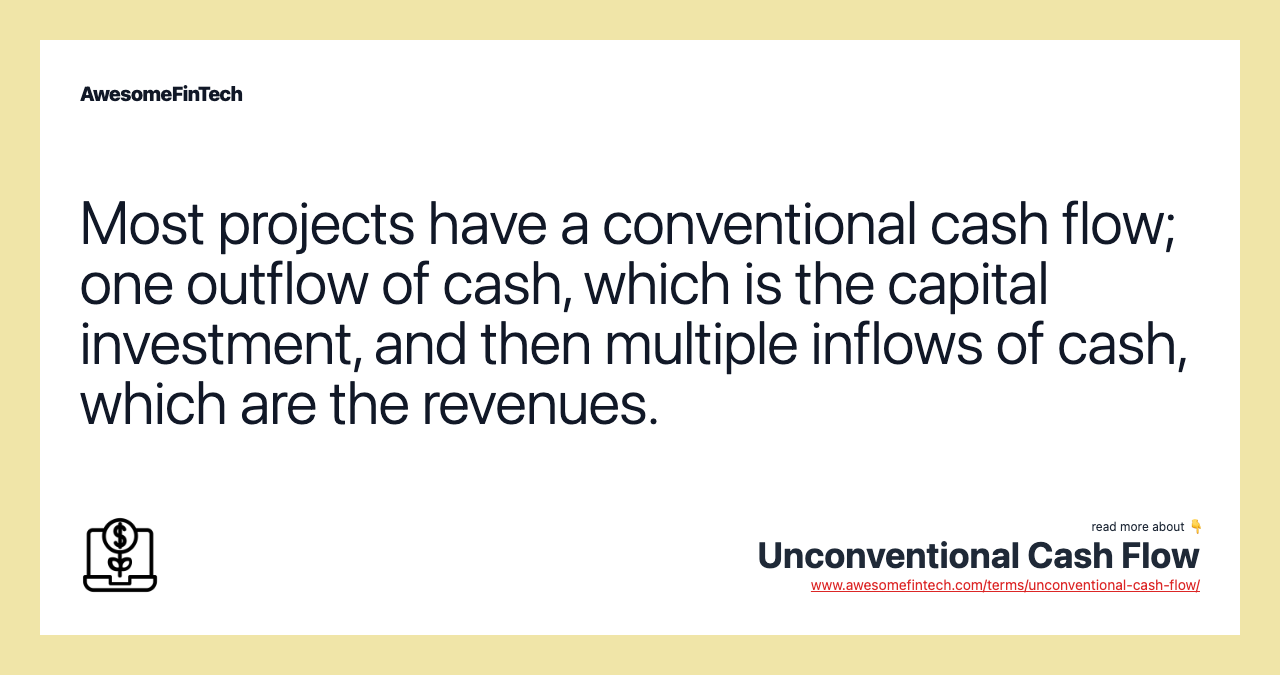
The cash flow statement is one of several financial statements issued by public companies, which also include a balance sheet and an income statement. Often, the outflow happens only at the beginning of the project, followed by subsequent inflows. The initial outflow is the capital that a company spends to finance the project. The cash inflows that follow represent the revenue and profits that the project yields. Unconventional cash flow, as noted above, is characterized by a series of cash flows in different directions.
Capital Allocation Concepts
Due to the multiple IRR problem and the unrealistic reinvestment rate assumption inherent in IRR methodology, net present value is the preferred capital budgeting tool. Since capital budgeting describes the process by which all companies make decisions on their capital projects, it is not unusual for some fairly sophisticated techniques to be employed in its execution. Regardless of this, capital budgeting relies heavily on just a few basic principles. Free cash flow formula tells you the difference between cash generated from standard business operations and cash spent on assets. Ultimately, it indicates your business’s financial performance and health, and ability to stay in business.
How to calculate free cash flow
- Evaluate cash flow, rental income against operating expenses, taxes, insurance, maintenance and mortgage payments.
- For example, a project with a higher IRR may not have a higher NPV, or a project with a shorter PP may not have a higher PI.
- To understand the examples and applications of conventional cash flow, delve into real estate investment analysis and capital budgeting and investment decision-making.
- Things like environmental and social impacts that might have long-term effects on a company’s reputation and profits are missed.
It starts with an initial cost, next are series of positive cash flows, at last, a final negative cash flow. As illustrated in the examples above, a conventional cash flow involves a series of transactions in a single direction. It creates just one IRR, which makes it very easy to evaluate investments.
How to calculate operating cash flow

For non-conventional cash flows, there may be multiple changes in the sign of the cash flows, which can result in multiple or no solutions for the IRR and complicate the calculation of NPV. Easier to apply the profitability index (PI) and the payback period (PP). The PI is the ratio of the present value of the cash inflows to the present value of the cash outflows. For conventional cash flows, the PI and the PP are straightforward measures of profitability and liquidity.
Understanding an Unconventional Cash Flow
This information helps borrowers understand the true cost of borrowing and assists lenders in evaluating loan applications. Capital budgeting analysts make an extraordinary effort to detail precisely when cash flows occur. We can see that project B has a unique and positive discounted payback period, which is less than the maximum acceptable payback period of 3 years, meaning that it is also acceptable and liquid. However, project A still has a lower discounted payback period than project B, meaning that it is more preferable.
What is the approximate value of your cash savings and other investments?
If the company’s inflows of cash exceed its outflows, its net cash flow is positive. Public companies must report their cash flows on their financial statements. This information can be of great interest to investors as an indicator of a company’s financial health, especially when combined with other data. Conversely, unconventional cash flows involve more than one change in cash flow direction and result in two rates of returns at different intervals. In other words, unconventional cash flows have more than one cash outlay or investment, while the entry to adjust the accounts for salariess only have one. Conventional cash flow projects can be compared and contrasted using different criteria such as NPV, IRR, PI, PP, and modified IRR (MIRR).
This can create difficulties and ambiguities in applying some capital budgeting techniques, such as irr and payback period. For example, a project with non-conventional cash flow may have multiple or no IRRs, making it hard to determine its acceptability and ranking. Similarly, a project with non-conventional cash flow may have multiple or no payback periods, making it hard to assess its liquidity and risk. A frequent application of conventional cash flow is the net present value (NPV) analysis. NPV helps determine the value of a series of future cash flows in today’s dollars and compare those values to the return of an alternative investment. The return from a project’s conventional cash flows over time, for example, should exceed the company’s hurdle rate or minimum rate of return needed to be profitable.
They looked strong based on reported profits and assets but had serious debt burdens. Closer examination of their cash flows could have prevented one of the most infamous corporate collapses in history. He will experience an unconventional cash flow if, after every three years, the property undergoes a maintenance check. Mutually exclusive projects are capital projects which compete directly against each other. For example, if a manager has projects X and Y and must choose either of the two and not both, then projects X and Y are said to be mutually exclusive. This scenario differs from independent projects, those whose cash flows are independent of each other and can, therefore, be undertaken together.
